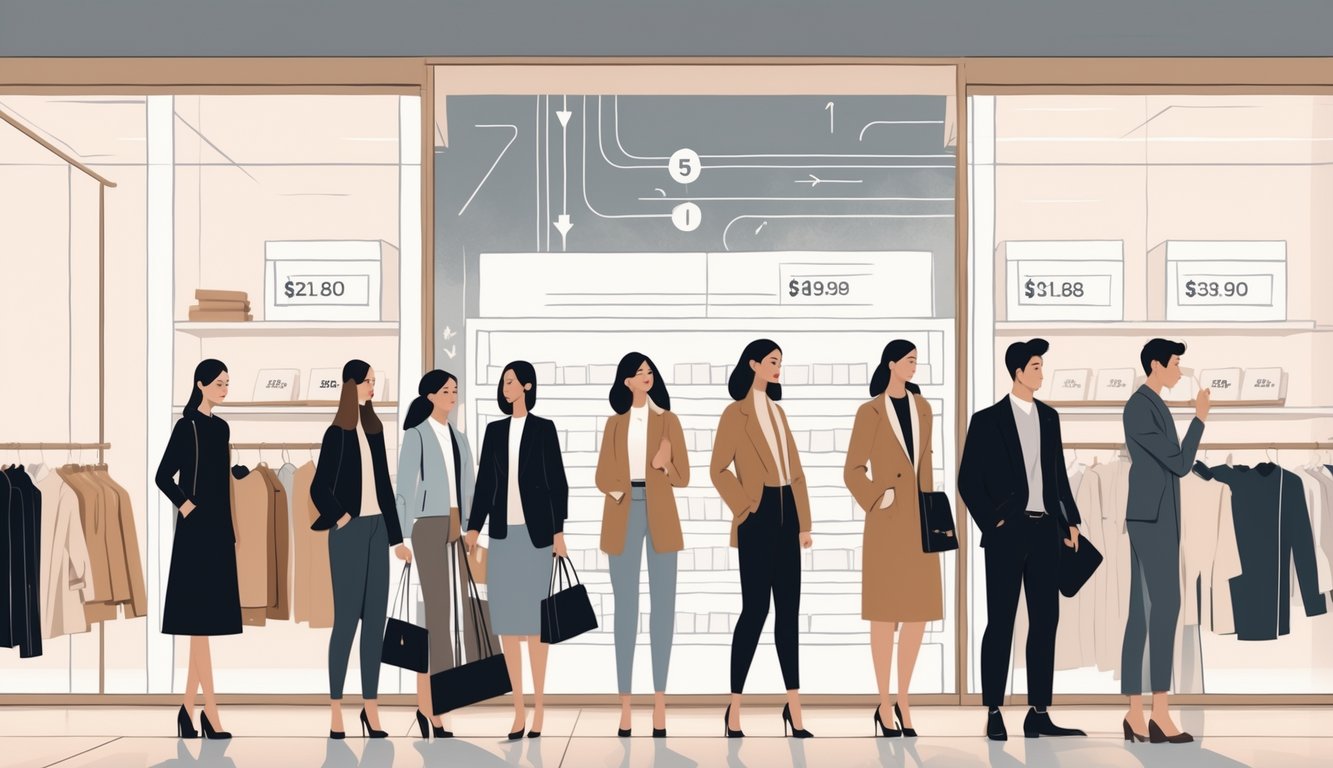
Impact on Personal Luxury Goods and Handbags
Right, so, luxury prices—especially for handbags and shoes—aren’t just “up.” They’re sprinting. Forget Hermès for a sec, even those so-called “entry” brands keep bumping up tags, sometimes two or three times a year, like we wouldn’t notice. And no, shoppers are not quietly accepting it. Brands keep trying to squeeze out profits, but it’s messy; they want to look exclusive but not so exclusive nobody buys. It’s a circus. Quarterly call optimism? Please.
Luxury Handbags as Investment Pieces
Look, if you think people still happily fork over for a Chanel Classic Flap after yet another 15% hike, you’re kidding yourself. Sales of luxury goods—especially handbags—have slowed to a crawl. Bain’s 2025 study? Brutal. The post-pandemic boom? Gone. “Creativity crisis”—yep, they actually call it that—means even resale value is shaky. Remember when a Birkin felt safer than stocks? Now? I can’t tell if it’s investment or just a weird gamble.
A resale consultant told me, “Inventory just sits now, buyers freeze if retail jumps three times in a year.” I see it every week on Vestiaire: bags that flew out the door in 2022 now just… linger. That untouchable aura? It’s fading, and brands haven’t figured out how to keep loyalists from bailing. And, seriously, why does a new LV tote sometimes cost more than a used Rolex when the stitching looks machine-done? Is it just me?
Trends in Luxury Shoes and Accessories
Every trade show, same vibe: “It’s all sneakers, no risks, just higher prices.” Where did the fun go? Milan’s Gucci Summer 2025 runway (June 17, if you care) felt… safe. Like, they tweaked old stuff. Bain’s data is crystal clear: price hikes, not real demand, are behind the tiny 4% bump in accessories sales. Global luxury sales are basically stuck at 362 billion euros.
I’m still wearing my beat-up loafers because €700 for “new” ones with a slightly different buckle? Hard pass. Meanwhile, brands quietly move factories, trim costs, and hope nobody notices. Do they email us about that? Nope. And my cousin’s out here “investing” in logo slides (yes, rubber sandals). If that’s the new normal, I give up.
Tourism and the Global Luxury Market
Trying to map how Asian tourists or Milan mobs mess with luxury sales? It’s chaos, honestly. CEOs and consultants act like they’ve got a formula, but tourists buy for reasons no spreadsheet can predict. Price hikes? Doesn’t matter, they’re still lining up.
Foreign Visitors and Tourist Spending
I used to laugh at those “seasonal swing” guides. The reality: it’s a year-round stampede. Japanese, Korean, U.S. tourists fill Florence boutiques, then hit Paris for tax refunds. Last year, nearly 40% of Europe’s luxury sales came from tourists—Bain said so—but not because locals quit. It’s more like an arms race. Strong euro? Nobody cares. Tourists want the receipts, the Instagram, the bragging rights. And even with sales stalling, they prop up the whole market.
You can name-drop Chanel, Vuitton, Prada, whatever, but it never covers the full madness. Are people buying another Celine belt in Paris for the “experience,” or just to dodge U.S. taxes? I have no clue. I’ve watched shoppers fight over VAT refunds, then drop another €2,000 because the clerk was nice. The receipts never tell the real story.
The Role of Asian Tourism
If you’re a luxury CEO, panic: Asian tourists see through every marketing trick. Chinese travel came back late post-COVID, but McKinsey keeps warning—one policy tweak, and billions reroute overnight. Pre-pandemic, Chinese tourists made up over a third of global luxury sales. Then borders closed, numbers crashed, now it’s limping back.
A Hong Kong buyer told me she skips Europe now—“overpriced, except Rome outlets.” Makes sense. Milan’s Galleria? Packed with Asian shoppers, but lately, Japanese and Koreans are buying Cartier in Zurich, not Paris, dodging currency swings. Asian tourism scrambles the “where” and “when” of luxury sales. Supply chains snap, then brands scramble to fix them. Nobody ever admits how fragile it all is.
Key Italian Cities for Luxury Shopping
Don’t believe the “Italy is luxury” hype. Milan locals avoid Gucci on Via Montenapoleone in August, but I met a Russian journalist who swears by it in November. Florence’s Via de’ Tornabuoni? Packed—global sales there nearly doubled post-pandemic, mostly thanks to tourists. Milan grabs more tourist cash than Rome when Asian traffic spikes, but Rome’s Spanish Steps win for jewelry. Why? Americans trust local gold stories, apparently.
Weird patterns everywhere: Venice shops spike after cruise ships dock, then tank with train strikes. Local spending never matches global sales. It’s always tourists shifting splurges to whatever city feels “special” that month. Price hikes just push everyone to hunt “exclusive” pieces—hence, every other customer waving WeChat in Florence. The Italian luxury map? It redraws itself every season, and anyone who says otherwise hasn’t stood in a Fendi line in June.
Creative Crisis and the Future of Luxury
Honestly, we should’ve seen the slowdown coming. Brands hike prices, but the “new” bags? Just more logos, less wow. The “creativity crisis” isn’t a joke—analysts say it, shoppers feel it. Handmade details matter more now, and nobody’s fooled by another celebrity campaign that looks like recycled leftovers.
The Importance of Craftsmanship
I can’t look at an “it bag” now without squinting: hand-stitched or factory? Old boutique owners in Milan just shake their heads—mass production’s killed the magic. Bain’s 2024 study calls out the creativity crisis, and you can see it—shoppers grill managers about hardware and stitching like amateur detectives.
Last week, a client dissected a “limited” tote, found uneven threads inside. Pro tip: check the back of the inner pocket—real handwork or just machine? The only products getting respect now are the ones where you can spot the difference, even if you need a magnifying glass and too much free time.
Maintaining Authenticity Amid Price Rises
What gets me isn’t the sticker shock, it’s loyal shoppers second-guessing if the brand is still “them.” Every third person near a luxury display mutters, “Does this still mean something?” I do it too—sat through a €4,000 pump presentation that looked like last season’s, just thinner soles. The more brands brag about heritage, the more shortcuts show.
It’s tough. Authenticity gets harder to fake when every price jump makes flaws pop. One regular brings his 1998 loafers every month to compare with “improved” versions. Why? He thinks the real value hides in details—secret codes, hand-lasted soles, stuff nobody brags about unless they’re obsessed.
Innovation Versus Tradition
Half the time, I’m stuck in this weird debate—should designers chase TikTok fame or go back to old-school weaving? No answer. At a trade show, a creative director admitted, “We tried bold, but customers want the classics.” Every “innovation” splits the room: some love the wild stuff, some complain about losing the old lines. So next season? Flip-flop again—minimal monogram, then neon python.
Honestly, real innovation happens behind the scenes: weird threads, upcycled horsehide, closures only patent lawyers care about. I’ve lost track of how many times someone whispers, “It’s a nod to our archives, but sustainable.” Hybrids are supposed to please everyone, but do they? Innovation’s necessary, but go too far and you lose the loyalists who want the weight, the feel, that weird calfskin smell.



